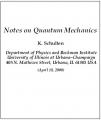
Introduction to the Time Evolution of Open Quantum Systems
by Angel Rivas, Susana F. Huelga
Publisher: arXiv 2011
Number of pages: 101
Description:
We revise fundamental concepts in the dynamics of open quantum systems in the light of modern developments in the field. Our aim is to present a unified approach to the quantum evolution of open systems that incorporates the concepts and methods traditionally employed by different communities.
Download or read it online for free here:
Download link
(750KB, PDF)
Similar books
 Quantum Models of Classical World
Quantum Models of Classical Worldby Petr Hajicek - arXiv
This paper is a review of our recent work on three problems of non-relativistic quantum mechanics: realist interpretation, quantum theory of classical properties and the problem of quantum measurement. A considerable progress has been achieved...
(7727 views)
 Quantum Information Theory
Quantum Information Theoryby Robert H. Schumann - arXiv
A short review of ideas in quantum information theory. Quantum mechanics is presented together with some useful tools for quantum mechanics of open systems. The treatment is pedagogical and suitable for beginning graduates in the field.
(16314 views)
 Notes on Quantum Mechanics
Notes on Quantum Mechanicsby K. Schulten - University of Illinois at Urbana–Champaign
These notes introduce Quantum Mechanics at an advanced level addressing students of Physics, Mathematics, Chemistry and Electrical Engineering. The aim is to put various mathematical concepts and techniques at the readers disposal.
(14398 views)
 The Cellular Automaton Interpretation of Quantum Mechanics
The Cellular Automaton Interpretation of Quantum Mechanicsby Gerard 't Hooft - Springer
This book presents the deterministic view of quantum mechanics developed by Gerard 't Hooft. 't Hooft has revived the old hidden variable ideas, but now in a much more systematic way. Quantum mechanics is viewed as a tool rather than a theory.
(6024 views)